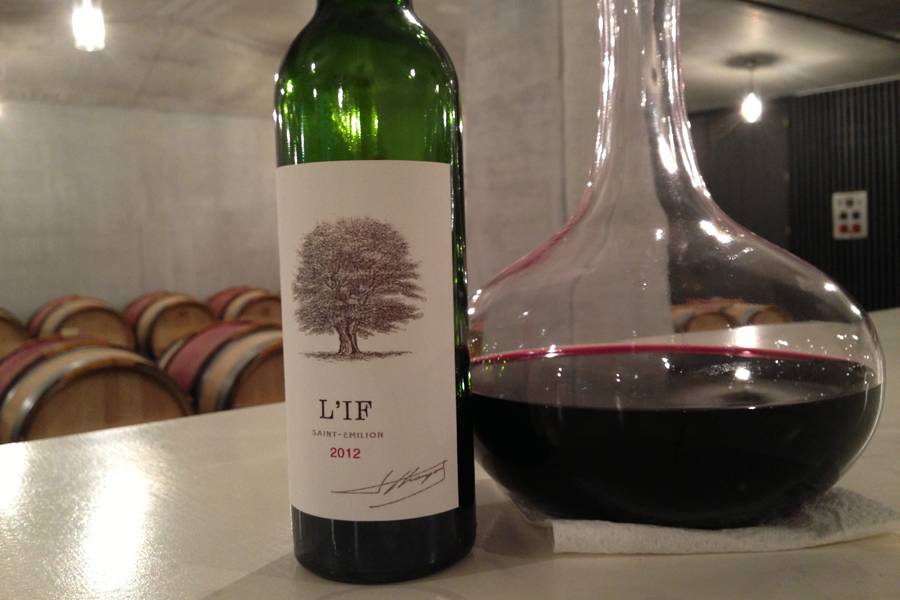- Colour Red
- Producer Château l'If
- Region St Emilion
- Drinking 2027 - 2050
- Case size 6x75cl
- Available Now
2020 - L'If St Emilion - 6x75cl
- Colour Red
- Producer Château l'If
- Region St Emilion
- Drinking 2027 - 2050
- Case size 6x75cl
- Available Now
Select pricing type
Need help? Call +44 (0)20 7793 7900 or email wine@goedhuiswaddesdon.com.
-
Neal Martin, December 2022, Score: 92
The 2020 L'If is precocious on the nose, with macerated black cherries, crushed violet, and blueberry emerging with time, all very well-defined and focused. The oak is nicely integrated here. The palate is medium-bodied with pliant tannins, a little fleshier than its stablemate L'Hêtre. A pinch of white pepper towards the second half and an almost sedate, harmonious pastille-like finish. This should be afforded 4-5 years in bottle. Drink 2025-2040
-
Neal Martin, May 2021, Score: 93-95
The 2020 L’If is the first to include the Cabernet Franc that Jacques Thienpont planted four years ago, representing 16% of the blend this year, the remainder is Merlot. It has a more open nose than the Le Pin tasted alongside, a mélange of red berry fruit, mint, iodine and a dab of liquorice. That Cabernet Franc lends a little pepperiness. The palate is very well balanced with seamlessly integrated new oak, plush and rounded. A more sensual wine than Le Pin this year, forward and generous with a ripe and very pure, mineral-driven finish. This will be difficult to resist, so don’t say I didn’t warn you. Drink 2026 - 2045
-
Antonio Galloni, December 2022, Score: 97
The 2020 L’If is dense, powerful and explosive to the core. A rush of black cherry fruit, chocolate, graphite, cloves and lavender saturates the palate. This powerful, dense Saint-Émilion is all muscle and brawn today. There is no shortage of intensity, but all of that energy is directed inwards at this stage. Huge tannins and bright acids need time to soften, but this is impressive. Readers should expect a big, big wine. Drink 2030-2050
-
Antonio Galloni, June 2021, Score: 95-97
The 2020 L'If is shaping up to be a jewel of a wine. In most vintages so far, L'If has been a dense, textured Saint-Émilion. In 2020, all of that energy seems directed toward extreme verticality rather than heft. I have to say, it’s a style I like a lot. Bright acids and persistent tannins drive a core of red/purplish fruit, while floral, spice and mineral-drenched accents linger. The 2020 is a blend of 84% Merlot and 16% Cabernet Franc, picked on 9/16, 9/24 and 9/26 for the Merlot and 10/1 for the Franc. This is the first vintage that includes fruit from a new parcel in the Saint-Étienne-de-Lisse district. A statuesque, captivating beauty, L'If is loaded with potential. I loved it. Drink 2030 - 2055
Producer
Château l'If

Region
St Emilion
South of Pomerol lies the medieval, perched village of St Emilion. Surrounding St Emilion are vines that produce round, rich and often hedonistic wines. Despite a myriad of soil types, two main ones dominate - the gravelly, limestone slopes that delve down to the valley from the plateau and the valley itself which is comprised of limestone, gravel, clay and sand. Despite St Emilion's popularity today, it was not until the 1980s to early 1990s that attention was brought to this region. Robert Parker, the famous wine critic, began reviewing their Merlot-dominated wines and giving them hefty scores. The rest is history as they say. Similar to the Médoc, there is a classification system in place which dates from 1955 and outlines several levels of quality. These include its regional appellation of St Emilion, St Emilion Grand Cru, St Emilion Grand Cru Classé and St Emilion Premier Grand Cru Classé, which is further divided into "A" (Ausone and Cheval Blanc) and "B" (including Angélus, Canon, Figeac and a handful of others). To ensure better accuracy, the classification is redone every 10 years enabling certain châteaux to be upgraded or downgraded depending on on the quality of their more recent vintages.




